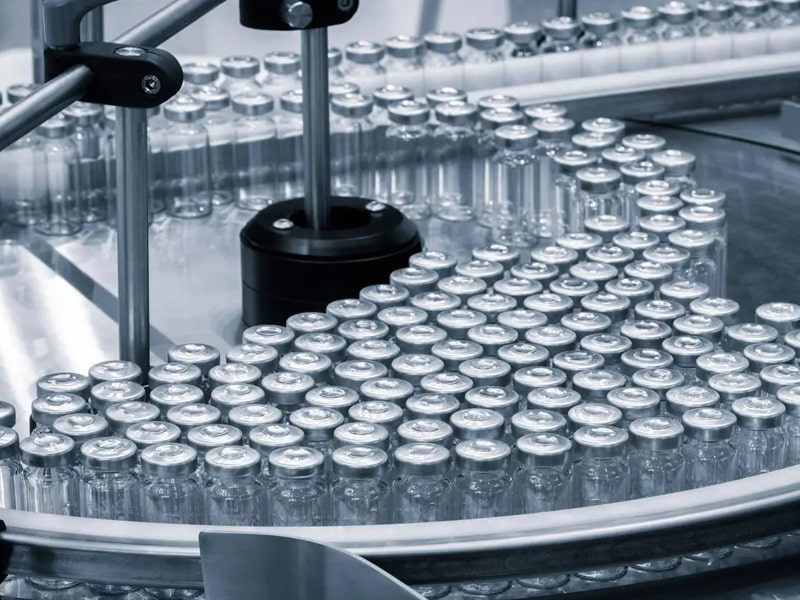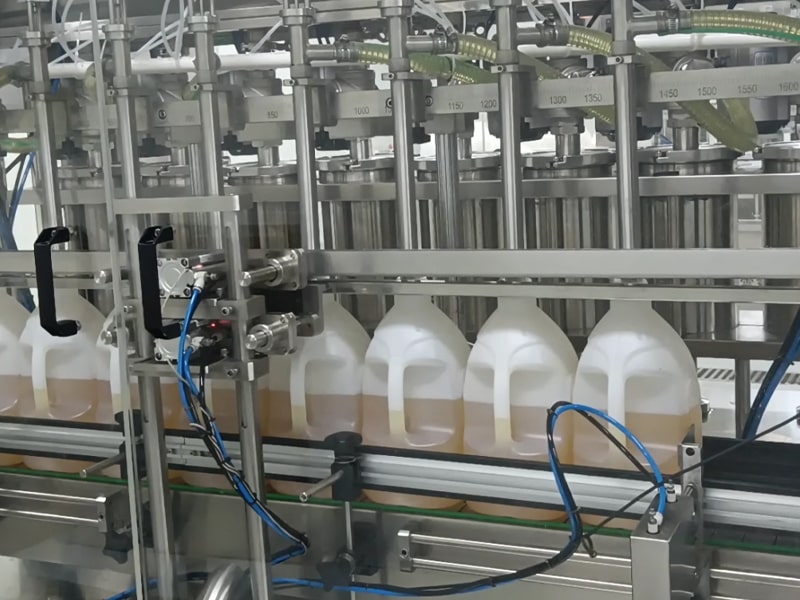Vial filling equipment consists of automated systems that feed, wash, fill and seal small glass or plastic vials under sterile conditions. These machines are essential in pharmaceutical and biotechnology production for precisely dispensing injectable liquids (vaccines, biologics, diagnostics, etc.) into vials. Vials offer high chemical resistance and safe drug storage, making them ideal containers for sensitive drugs. Modern vial filling machines can process hundreds of vials per minute with accurate volumetric control and minimal product loss. Such systems often integrate filling pumps, stoppering/capping heads, and inspection stations in cleanroom environments to meet strict GMP requirements.

Vials (small sealed bottles) are typically filled by specialized machines in sterile pharmaceutical packaging lines. These machines automate feeding, washing, filling and sealing vials at high speeds (hundreds per minute) with precise dosing. The example above illustrates typical sterile vials and stoppers produced by an automatic filling/closing machine.
Modern vial filling lines often use rotary or linear platforms to optimize throughput. For instance, the equipment below shows a rotary carousel that handles vials in bulk. Such machines are designed to operate in Class 100 cleanrooms for aseptic filling of injectable drugs (e.g. vaccines, biologics), ensuring sterility and zero contamination.
High-speed vial filling machines (like the rotary system shown above) are designed for sterile environments. These systems precisely dispense, stopper and seal vials in continuous batches. Modern pharmaceutical producers use them to reliably fill hundreds of small containers per minute with consistent accuracy.
Industries Using Vial Filling Machines
Vial filling equipment is mainly used in the pharmaceutical and biotechnology industries, where injectable products demand sterile precision. Industry segments include vaccine manufacturing, sterile drug (insulin, monoclonal antibodies) production, laboratory reagents, and biotech R&D. Many filling lines are installed in hospitals’ compounding pharmacies and CDMOs (contract manufacturers) as well. Beyond pharma, related sectors also use vial filling machinery: for example, cosmetic companies fill small vials of serums or perfumes, and nutraceutical/chemicals firms may fill ampoules or vials with specialized liquids. In practice, leading machine suppliers report that their vial filling and closing machines serve pharmaceuticals, consumer healthcare, cosmetics, nutraceuticals and related fields.
The critical factor is sterility: most vial filling lines operate in cleanrooms with aseptic barriers, depyrogenation tunnels and HEPA filtration to prevent contamination. Thus, manufacturers emphasize cGMP compliance and isolator technology for vial filling machines. In short, any industry needing high-purity liquid filling – especially for medical injectables – is the primary user of vial filling and sealing machines.
Vial Filling Equipment Market Overview
The global market for automated filling machines is large and growing. One report valued the total global filling machines market (across food, pharma, chemical, etc.) at about $8.88 billion in 2021, with an expected CAGR of ~4–5%. This broad figure underscores strong demand for filling lines in many sectors. Focusing on vial filling specifically, specialized robotic filling and washing systems are also expanding. Precedence Research estimates the robotic vial washing and filling machines market was ~$562.94 million in 2024, projected to reach $867.56 million by 2034 (CAGR ~4.4%). The growth is driven by rising production of biologics, vaccines and personalized medicines, all requiring high-speed aseptic vial filling.
Overall, analysts note that accelerating demand for injectables (mRNA vaccines, monoclonal antibodies) and tight sterility regulations are fueling investment in new vial filling lines. As pharmaceutical production shifts towards small-volume, high-value batches, manufacturers seek flexible vial filling machinery that can handle diverse vial sizes with minimal downtime. Industry research highlights trends like automation and robotics integration for efficiency, plus the move to isolator-based aseptic lines for safer, closed filling of vials.
Top 10 Vial Filling Equipment Manufacturers
Below are ten leading companies worldwide that specialize in vial filling machinery. (Ranked here for coverage, with Guangzhou SFXB and Yundu included per request.) Each firm’s key profile and markets are described:
- Guangzhou SFXB Special Equipment Co., Ltd. (China) – SFXB is a Chinese manufacturer of custom automated filling production lines. Since 2000 the company has focused on non-standard automatic filling line solutions. It offers vial filling machines, capping, labeling and other equipment, serving pharma, food/sauce, cosmetics and health-product lines. SFXB emphasizes in-house R&D and a wide product range; its machines are used domestically and exported abroad. (Note: SFXB’s own site highlights its role as a specialist in turnkey filling systems covering the full production line.)
- Guangzhou Yundu Machinery Technology Co., Ltd. (China) – Yundu is a major Chinese liquid/vial filling line supplier with over 20 years’ experience. Its portfolio includes washing, sterilizing, filling and capping systems for small vials (2–30 mL) in a single aseptic line. Yundu reports its machines serve industries like pharmaceuticals, food & beverage and cosmetics. The company highlights its global presence (“machines in 100+ countries”) and R&D-driven innovation. Yundu’s lines are used for products ranging from oral liquids to injectable solutions, focusing on high throughput and quality in sterile filling.
- Syntegon (Germany) – Formerly Bosch Packaging Technology, Syntegon is a German-based global leader in pharmaceutical and food packaging equipment. With over 150 years of experience, Syntegon specializes in high-end aseptic filling machines. Its vial filling systems (like the ALF and Versynta series) provide modular, flexible platforms for liquid pharmaceuticals. Syntegon machines are known for high output, integrated inspection and precise CIP operations. As a world-class machinery builder, Syntegon serves major drug manufacturers worldwide with complete fill-finish lines (filling, stoppering/capping, labeling) for vials and other containers.
- Groninger (Germany) – Groninger is a leading German manufacturer of filling and closing machines for the pharmaceutical, healthcare and cosmetics industries. The company’s vial filling equipment includes compact and rotary aseptic fillers that handle washing, sterilizing, filling and stoppering of glass vials. Groninger emphasizes flexibility and quality; its lines serve ready-to-use (RTU) syringes and vials, with outputs from lab scale up to large production. With ~1,500 employees and global operations, Groninger is well-known for its customizable cleanroom solutions and has a strong presence in Europe and the USA.
- AIPAK Pharma Machinery Co., Ltd. (China) – AIPAK is a Chinese turnkey solution provider for pharmaceutical production and packaging. Over 15 years, AIPAK has supplied capsule fillers, tablet counters, blister machines and liquid filling lines (including vial fillers) to global pharma and biotech companies. Its equipment meets GMP and CE standards. AIPAK’s customers are in pharmaceutical, cosmetics, food & beverage and daily-chemical industries. The company claims over 100 country exports and focuses on integrating imported components for high-precision filling. AIPAK machines handle sterile injectable lines as well as general packaging needs.
- Cozzoli Machine Company (USA) – Established in 1919, Cozzoli (New Jersey, USA) is a century-old builder of precision filling and packaging machinery. A recognized global leader, Cozzoli manufactures automatic cleaning, sterilizing, filling and capping machines for vials, bottles, ampoules and syringes. Its product line includes rotary, shuttle and linear filling machines for aseptic and non-aseptic applications. Cozzoli equipment is widely used in pharmaceutical and biotech production as well as industrial and food sectors. The company prides itself on “go-to” support and customizing machinery to customer specifications.
- ARxIUM (USA) – ARxIUM (formed from IMA Life and others) focuses on pharmacy automation and dispensing solutions. Its FastFill line of vial fillers is designed for high-throughput compounding and outpatient pharmacies. ARxIUM’s systems automate the filling of sterile vials in hospital or retail pharmacy settings. According to its materials, ARxIUM’s vial filling machines deliver high script volumes for the pharmaceutical industry. Although smaller in scale than industrial fillers, ARxIUM equipment is important for hospital central fill operations and specialty pharmacies managing injectable therapies.
- AST, Inc. (USA) – AST (Advanced Systems Technology) specializes in advanced aseptic filling and closing systems for the life-sciences industry. The company designs flexible fill/finish solutions (ASEPTiCel®, GENiSYS) that process vials, syringes and cartridges under sterile barrier technology. AST’s products (e.g. GENiSYS® C and R) are modular systems enabling fully automated processing of nested (RTU) vials and syringes with integrated laminar flow cabinets. With roots going back to 1965, AST’s machines serve pharmaceutical and biotechnology manufacturers, especially for clinical and small-scale production under strict cGMP.
- MGA Technologies (France/Canada) – MGA is a Franco-Canadian engineering firm that builds custom vial filling lines. Its equipment is used in sterile pharmaceutical, cosmetic, food and chemical plants. MGA’s expertise lies in adapting machines to specific production needs: they offer everything from semi-automated benchtop fillers to complete automated vial filling and capping lines. They emphasize modular design and the ability to work in aseptic zones when required. While smaller than some global brands, MGA has built a reputation for tailor-made vial filling machines and complete production cells for mid-size customers.
- Bausch+Ströbel (Germany) – Bausch+Ströbel is a German “world market leader” in pharmaceutical packaging machinery. It designs and produces highly sophisticated automatic lines for vials, bottles, syringes, ampoules and RTU cartridges. The product range covers washing, depyrogenation, filling (liquid or powder), and integrated downstream operations. Their machines range from lab-scale semi-automatics to high-speed production lines handling up to 60,000 containers per hour. Bausch+Ströbel equipment is renowned for quality and customization; they frequently develop customer-specific solutions for injectables, often including complete turnkey lines.
 |
| Double servo ceramic pump filling, plugging, capping and capping machine |
Industry Trends and Insights
The market for vial filling equipment is evolving toward greater automation, flexibility and sterility. Key trends include:
- Automation and Industry 4.0 – Manufacturers are integrating robotics, PLC controls and AI-driven monitoring to boost throughput and reduce human intervention. Automated traceability and vision inspection ensure each vial is filled correctly and contaminant-free.
- Aseptic Isolation Technology – With tightening regulations, many new lines use closed isolators and robotic arms to eliminate cross-contamination. This is critical for handling toxic or biologic drugs. Machine suppliers are developing isolator-based vial fillers and integrated clean-in-place (CIP) systems.
- Customized Flexible Lines – Drug diversifications (e.g. personalized medicine) require small-batch flexibility. Companies now offer vial filling systems with quick-change features for different vial sizes and formats. Modular designs allow customers to reconfigure lines for evolving products.
- Global Expansion – Strong pharma growth in Asia, Latin America and the Middle East is driving new factories. Manufacturers like SFXB, Yundu and AIPAK are capitalizing on this by expanding overseas, while established Western firms partner or open facilities locally.
- COVID‑19 and Vaccines – The pandemic has accelerated demand for sterile filling capacity. Many top filling equipment makers received orders for vaccine vial lines. Going forward, sustained vaccine production will keep focus on high-throughput aseptic fillers.
Conclusion
Vial filling equipment is a critical segment of pharmaceutical packaging, enabling safe, efficient production of injectable therapies. The major machine manufacturers listed above – from Chinese innovators like SFXB and Yundu to global leaders like Syntegon, Groninger, and Bausch+Ströbel – drive advances in filling speed, precision and sterility. As the demand for biologics and vaccines grows, these companies are continually innovating with faster, more flexible vial filling and sealing machines. Their specialized technologies ensure that every drop of liquid medicine is accurately dispensed into its vial, meeting the highest quality standards. For any pharmaceutical or biotech operation planning to upgrade its filling lines, reviewing the offerings of these top manufacturers is an excellent start.
Frequently Asked Questions (FAQ) About Vial Filling Equipment
1. What is vial filling equipment?
Answer:Vial filling equipment is automated machinery used in sterile environments to feed, wash, fill, stopper/cap, and often label small glass or plastic vials at high speeds. These systems use precise volumetric or piston pumps to deliver exact dosages for injectable pharmaceuticals, typically integrating into cleanroom production lines.
2. Which industries commonly use vial filling machines?
Answer:Vial filling machines are primarily used in:
• Pharmaceuticals – for injectables like vaccines and biologics
• Biotech/laboratory – filling diagnostic reagents and research compounds
• Veterinary – packaging animal injectables
• Cosmetics – filling serums or small-volume products under sterile standards
• Nutraceuticals/chemicals – working with sensitive or high-purity liquid formulations
3. How large is the market for vial filling equipment?
Answer:The global filling machine market reached approximately $8.9 billion in 2021, growing around 4–5% annually. Specifically, the robotic vial filling and washing systems market was valued at $563 million in 2024, expected to reach $868 million by 2034, driven by demand for vaccines, biologics, and small-batch injectable manufacturing.
4. What types of filling technology are used in vial filling machines?
Answer:Common technologies include:
• Rotary Piston Pumps – for accurate dosage and high pressure
• Peristaltic Pumps – ideal for contamination-sensitive liquids
• Rolling Diaphragm Pumps – prevent fluid from contacting internal parts
• Time-Pressure Fillers – use pressurized tanks with timers for metering
These systems allow handling of different viscosities and precision requirements.
5. What is a vial filling line?
Answer:A vial filling line is a coordinated suite of machines—including vial feeders, washers, sterilizers (depyrogenation tunnels), filling and stoppering units, cappers, and inspection or labeling modules. This integrated setup automates the entire aseptic compartmentalized production process.
6. How is sterility maintained during vial filling?
Sterility is preserved through:
• Cleanrooms (ISO Class 5–7 with HEPA filtration)
• Aseptic technologies like isolators or RABS
• Automated washing and depyrogenation before filling
• Sterile filling under barrier systems, with minimal human contact
7. What are key considerations when choosing vial filling machinery?
Answer:Factors include:
• Product viscosity – does it suit piston, peristaltic, or pressure-based filling?
• Desired throughput – aligning fill heads and automation level
• Container compatibility – needed flexibility for vial sizes
• Cleanability – CIP capability for sterile compliance
• Scalability – ability to upgrade modular lines
• Regulatory adherence – GMP, FDA, EMA standards
8. Are vial filling machines flexible for different vial types?
Answer:Yes. Most machines are designed with quick-changeover features to handle various vial sizes (2–30 mL). They use modular change parts, adjustable rails, and servo-controlled fill heads for easy flexibility between production campaigns.
9. Do vial filling machines include inspection and rejection features?
Answer:Absolutely. High-quality lines incorporate vision systems, weight checkers, and leak detectors to ensure proper fill level, stopper/cap integrity, and no particulate contamination—all crucial for pharmaceutical safety and regulatory compliance.
10. What are the benefits of using automated vial filling systems?
Answer:Automated systems offer: • High throughput (hundreds to thousands of vials/minute) • Enhanced fill accuracy (<1% deviation) • Lower contamination risk from reduced human contact • Traceability and uniformity in production • Operational efficiency via robotics and PLC controls • Easier compliance with aseptic and cleanliness regulations
| References: | |
| 1. | Pharmaceutical vial filling machines market size (USD 975.8 M in 2024, projected USD 1.31 B by 2033, CAGR 3.3%) ——Retrieved from:MarketReportsWorld |
| 2. | Worldwide Liquid Vial Filling Service Market Research Report 2025, Forecast to 2031 ——Retrieved from:Pmarketresearch |
| 3. | Vial filling & capping machine projections ——Retrieved from:Verifiedmarketreports |
| 4. | Vial filling & stoppering machines:Valued at USD 1.5 billion in 2022, expected to rise to USD 2.8 billion by 2030 (CAGR 8.5%) ——Retrieved from:Verifiedmarketreports |






Comments